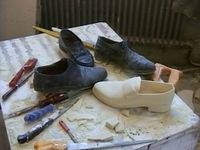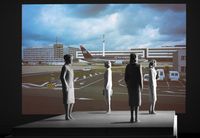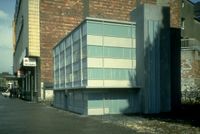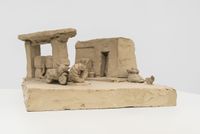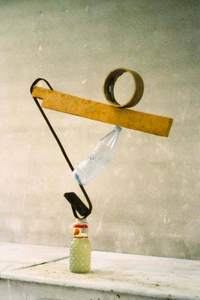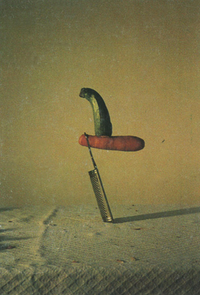Peter Fischli and David Weiss, commonly known as Fischli and Weiss or Fischli/Weiss, collaborated from 1979 until Weiss' death in 2012. The artist duo is known for their examination of the banal as a subject of art, incorporating commonplace objects into vignettes and sculptural arrangements that are characterised by mock-seriousness and a suggestion of ordinary yet humorous narratives.
Read MoreThe deliberately amateurish treatment of materials seen in many of Fischli and Weiss' works is evident in the 'Sausage Photographs' (1979)—their first collaboration—which consists of 10 photographs depicting everyday scenes made up of sausages and sliced meat. Sausages are dressed up in Sausage Fashion Show, while piles of hams and lunchmeat alongside small sausage figures suggest a carpet shop scene in At the Carpet Shop, and sausage cars collide in The Accident.
Wit and encyclopaedic collections come together in Fischli and Weiss works such as Suddenly This Overview (1981/2006). Across the hundreds of small-scale, unfired clay sculptures, the artist duo constructed vignettes of major and minor events in the history of the world, including Mick Jagger and Brian Jones Going Home Satisfied after Composing 'I Can't Get No Satisfaction'; everyday objects, like a loaf of bread; and opposites such as theory and practice, and large and small.
In text, too, Fischli and Weiss traversed insightful, mundane, and downright silly questions and insights about the world at large. The booklet Order and Cleanliness (1981) contains charts, diagrams, and drawings that gather together knowledge from a vast range of inquiries. Other such collections include the sculptural vortex of questions titled Question Pot (Big) (1986) and slide projection set Questions (2002–2003).
A rat and bear are recurring figures in Fischli and Weiss' work, first appearing in the Super 8 film The Least Resistance (1980–1981). Unfolding in Hollywood, the artists, donning rat and bear costumes, find themselves entangled in a murder in their pursuit of success. The animal costumes reappeared in a number of works, including Rat and Bear (Sleeping) (2008): a floor installation in which the pair are seemingly in slumber on a pile of blankets.
Fischli and Weiss further engaged with the banal and absurd in Equilibres (A Quiet Afternoon) (1984–1986): a collection of surreal photographs in which chairs, kitchen utensils, bottles, and tyres, among other items, are captured in precariously balanced arrangements. The objects topple and fall in The Way Things Go (1987)—a film directly inspired by Equilibres (A Quiet Afternoon). First screened as part of documenta 8, the video became one of Fischli/Weiss' most known and popular works.
The artist duo is also recognised for their polyurethane sculptures, painstakingly hand-carved and painted to emulate various objects. A somewhat apocalyptic narrative can be glimpsed in the floor installation The Raft (1982), in which an assortment of objects, from a cannon to a pig with its piglets, are stacked on a raft surrounded by crocodiles and hippopotami, all rendered true to life in polyurethane.
How to Work Better, a major retrospective exhibition of Fischli and Weiss' work from their 33 years in collaboration, was organised by the Solomon R. Guggenheim Museum, New York, in 2016. It travelled to Museo Jumex, Mexico City, later in the same year. Another major retrospective, Flowers & Questions was held at Tate Modern, London, in 2006 and represented the duo's first retrospective in the United Kingdom.
Should I paint a pirate ship on my car with an armed figure on it holding a decapitated head by the hair? Sprüth Magers, London (2020); HAUS, Sprüth Magers, Berlin (2019); Snowman, Art Institute of Chicago (2017); Visible World, LUMA Arles, France (2017); Calder & Fischli/Weiss, Fondation Beyeler, Basel (2016).
Positions on Photography, Galerie Eva Presenhuber (2020); Useless: Machines for Dreaming, Thinking, and Seeing, The Bronx Museum of the Arts, New York (2019); Our Happy Life: Architecture and Well-Being in the Age of Emotional Capitalism, Canadian Centre for Architecture, Montreal (2019); Spiegelgasse (Mirror Alley), Hauser & Wirth, London (2018); Generation Loss: 10 Years of the Julia Stoschek Collection, Düsseldorf (2017); The Long Run, The Museum of Modern Art, New York (2017).
Sherry Paik | Ocula | 2020
